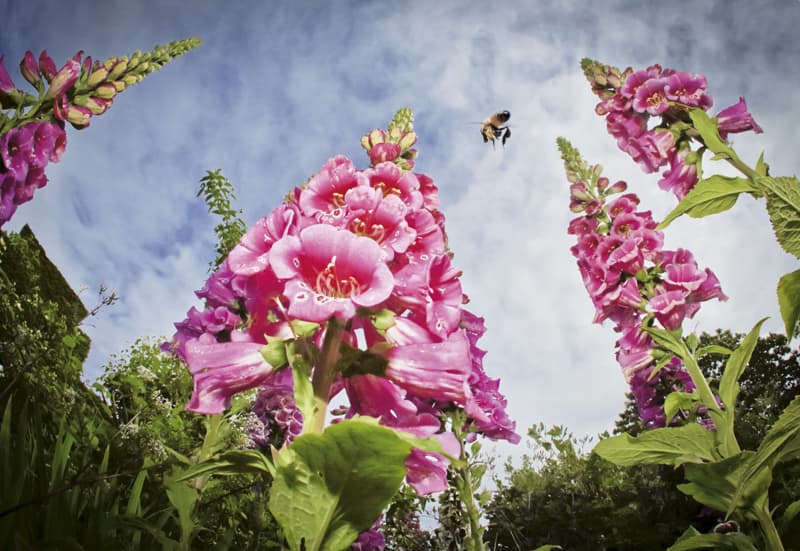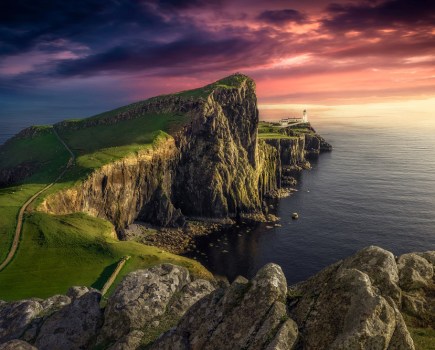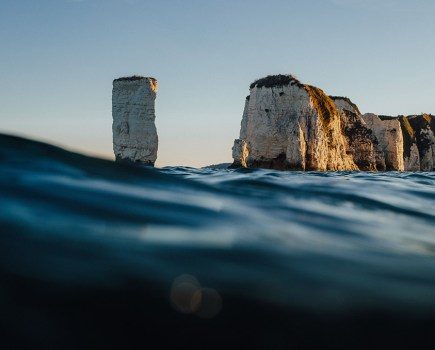photo by Heather Buckley
We’ve all taken pictures in our gardens, but it’s probably safe to assume that few of us have gardens like those at Great Dixter, which runs to some four acres, is designed by a world-famous architect and boasts 18 topiary birds, a formal pool and a Tudor hall at its heart. Great Dixter Gardens, near Rye in East Sussex, is renowned for its fusion of English country-cottage style with the exotic and the experimental, and if it’s colour, texture and architectural features you’re after, there’s no better place to visit. The real gift of a wonderland like this is that it will inspire you to make the photographic most of what your own garden has to offer – colour, contrast and natural patterns.
On a cool, damp June morning, Tom Mackie and five AP readers meet outside the gates at 8.30am for a quick run-through of what to expect from the day’s Masterclass. The gardens don’t open to the public until 11am, so that gives us plenty of time to go for undisturbed shots with Great Dixter House at their centre before the gardens fill up with people. However, the weather forecast isn’t promising, with monsoon-style rain due to set in at midday. So with the sky sullenly leaden, it’s unanimously agreed that we’ll take photographs until the heavens open, then head to the local pub for lunch, a debrief and a questions session with Tom.
‘With any garden, it’s a good idea to get there before the public arrive and concentrate first on scene-setting shots where people might otherwise be in the frame,’ says Tom. ‘But with the type of weather we’re facing, it really illustrates the importance of planning your shoot according to the quality of light available.’
 photo by Heather Buckley
photo by Heather Buckley
Tom says that if it’s sunny, you can happily go for those broader shots that will also capture the sky, but if it’s bright yet overcast, it’s better to go for closer-range shots.
‘A grey sky in a frame will deaden a picture, but the type of light you get with it is perfect for flower photography,’ says Tom. ‘It’s nice to see things with a fresh eye, so we’ll have a quick walk around to decide on our main wide scene-setting shots and go for them first, taking care to minimise the amount of grey sky in them. Then we’ll be taking a variety of plant portraits, using a reflector to fill in and keep the contrast as low as possible.’
Lastly, Tom suggests looking out for features such as pathways, topiary, fountains and benches. So with that last piece of advice, the readers venture into the lush gardens of Great Dixter with their cameras and tripods in hand.
Your AP Master…
 Tom Mackie
Tom Mackie
A former contributor to AP’s Photo Insight series, Tom Mackie is one of the world’s leading photographers. He has spent many years as an architectural, industrial and landscape photographer, and has a penchant for panoramic photography. Tom has published several books and written numerous articles for photography magazines. He also lectures on photography and regularly holds workshops in the UK and abroad. ww.tommackie.com
The AP readers...
 Heather Buckley
Heather Buckley
Heather mainly shoots street photography. She uses a Canon EOS 5D Mark III and 16-35mm, 8-15mm fisheye and 100mm macro lenses. ‘I’ve learned something outside my comfort zone,’ she says.
 Peter Goodman
Peter Goodman
Peter enjoys macro and wildlife and uses a Nikon D7000 with 18-105mm and 70-200mm zoom lenses. ‘I wanted to learn so much about composition and using filters,’ he says.
 Chantal Clonsdale
Chantal Clonsdale
Chantal enjoys street photography using her Canon EOS 400D with 10-22mm and 18-55mm zoom lenses. ‘There’s nothing better than getting one-to-one advice from someone who’s so experienced,’ she says.
 Philip Smith
Philip Smith
Philip shoots landscapes with his Canon EOS 5D Mark II and 24-105mm lens. ‘I’ve got lots of tips, including balancing the light and realising you don’t need the sun for great garden shots,’ he says.
 John Warren
John Warren
John loves shooting natural history close-ups. Today’s he’s using a Canon EOS 5D with 16-35mm, 70-200mm and 100mm macro lenses. ‘I’ve really enjoyed it a great deal,’ he says.

- Location: Great Dixter, Northiam, near Rye, East Sussex TN31 6PH. Tel: 01797 252 878. Website: www.greatdixter.co.uk.
The Great Dixter House and Gardens,are located just off the A28 near picturesque Rye in East Sussex. The gardens feature natural ponds, yew topiary, meadow flowers, dazzling mixed borders, the famed Exotic Garden and numerous medieval buildings. They provide superb scope for photography - Opening times: Open 1 April-28 October, Tuesdays to Sundays and Bank Holiday Mondays. The gardens are open from 11am-5pm (last admission), and the house from 2-5pm. Amenities include a café and plant nursery.
- Admission charges: Prices include Gift Aid (standard charge in brackets)
Gardens only: adult £8.25 (£7.50), child £4.40 (£4) House and gardens: adult £10.45 (£9.50), child £5.50 (£5).
Would you like to take part?

Every month we invite three to five AP readers to join one of our four experts on a free assignment over the course of a day. The experts are Tom Mackie (landscapes), Cathal McNaughton (documentary and photo essays), Annabel Williams (location portraiture) and Andy Rouse (wildlife). Our next confirmed Masterclass will be with Annabel Williams in August. If you would like to take part, visit transport.kelsey.host/amateurphotographer/masterclass for details of how to apply. Please remember to state which Masterclass you would like to attend and make sure you include your name, address, email address, daytime telephone number, some words about your work and three or four of your images.
Garden Gear
For a garden photography kit to cover all the bases, Tom suggests:
- Four
main lenses, comprising a wideangle zoom such as a 16-35mm, a standard
zoom like a 24-105mm, a telephoto zoom such as a 70-200mm and a 100mm
macro, which together will enable you to take everything from
scene-setting wide shots to detailed close-ups and portraits - A polarising filter for boosting contrast and reducing reflections on foliage
- A portable diffuser to soften harsh light
- A pop-up reflector for fill-in light

To
guarantee rock-steady shots, play safe with a tripod and cable release.
Using a tripod also has the effect of slowing you down and making you
think more carefully about your composition. Tom recommends a
lightweight tripod of carbon construction. Just remember that when you
use a tripod you need to turn off image stabilisation on lenses that
have this feature. If you leave it on, it can end up creating unsharp
images.
For any outdoor work, you might find a screen loupe
useful, as it fits over a camera’s LCD screen to allow for clear viewing
and image review. Also, a hotshoe spirit level will help ensure
straight horizons, and can be picked up for just a couple of pounds from
a variety of websites.
Choosing the right lens
When
you’re shooting gardens, your selection of lenses will enable you to
cover different types of effects and features. The 16-35mm optic will
provide sweeping overviews and broad shots; a general-purpose 24-105mm
lens is ideal for capturing medium-wide shots and telephoto views
without having to change lenses; the 70-200mm telephoto zoom will
comfortably cover both tight portraits and distant details; and the
100mm macro lens is great for floral portraits. Just select your lens
according to the effect you’re after.
It’s a great idea to
explore different focal lengths with the same shot, too – so the main
garden view, with Great Dixter Hall in the background, would work
equally well with a short wideangle zoom for front-to-back sharpness or
with a telephoto zoom for a tight crop on foreground detail such as
topiary, using a smallish aperture to give good depth of field.

photo by Peter Goodman
‘A
telephoto zoom can enable you to isolate details in a broader garden
scene, such as an archway cut through a hedge,’ says Tom. ‘It’s also
great for compressing features, especially a long pathway with, for
example, a bench or statue at the end – you can use a telephoto to
foreshorten everything and make the bench look bigger and more impactful
in the frame.’
To lose distracting backgrounds from tight flower
portraits, Tom suggests using a macro lens or the longer end of your
telephoto zoom – but take care not to go physically closer than the
close-focus distance allows, otherwise you’ll struggle to focus. Be
prepared to step back to get the focus spot-on.
‘A fisheye can
be interesting for gardens, providing some unusual floral perspectives
and angles,’ says Tom. ‘Try shooting upwards at flowers from ground
level using a burst of fill-flash to balance the exposure of the flowers
with that of the background sky.
I’ve often photographed from a
bug’s-eye view using a fisheye or wideangle lens, setting the camera
right down in the flowers looking up to the sky – it’s great for
brightly coloured petals, especially yellow, red and orange, against the
blue of the sky.’
Working with light and reflectors

photo by Philip Smith
When you’re shooting gardens, your selection of lenses will enable you to cover different types of effects and features.
The 16-35mm optic will provide sweeping overviews and broad shots; a
general-purpose 24-105mm lens is ideal for capturing medium-wide shots
and telephoto views without having to change lenses; the 70-200mm
telephoto zoom will comfortably cover both tight portraits and distant
details; and the 100mm macro lens is great for floral portraits.
Just select your lens according to the effect you’re after.
It’s
a great idea to explore different focal lengths with the same shot, too
– so the main garden view, with Great Dixter Hall in the background,
would work equally well with a short wideangle zoom for front-to-back
sharpness or with a telephoto zoom for a tight crop on foreground detail
such as topiary, using a smallish aperture to give good depth of field.
‘A
telephoto zoom can enable you to isolate details in a broader garden
scene, such as an archway cut through a hedge,’ says Tom. ‘
It’s
also great for compressing features, especially a long pathway with, for
example, a bench or statue at the end – you can use a telephoto to
foreshorten everything and make the bench look bigger and more impactful
in the frame.’

photo by Gill Mullins
To
lose distracting backgrounds from tight flower portraits, Tom suggests
using a macro lens or the longer end of your telephoto zoom – but take
care not to go physically closer than the close-focus distance allows,
otherwise you’ll struggle to focus.
Be prepared to step back to get the focus spot-on. ‘A fisheye can be interesting for gardens, providing some unusual floral perspectives and angles,’ says Tom.
‘Try
shooting upwards at flowers from ground level using a burst of
fill-flash to balance the exposure of the flowers with that of the
background sky.
I’ve often photographed from a bug’s-eye view
using a fisheye or wideangle lens, setting the camera right down in the
flowers looking up to the sky – it’s great for brightly coloured petals,
especially yellow, red and orange, against the blue of the sky.’
Depth of Field
Tom
points out to the group that they must always be aware of the
background, otherwise there is the risk that it could intefere with the
main subject of the image. Highlights around a flower and a defocused
background produce great results, with all the distracting elements
removed so that nothing can detract from the subject.
 photo by Heather Buckley
photo by Heather Buckley
‘To
get this type of effect, you need a shallow depth of field,’ says Tom.
‘A shallow depth of field relies on a wide-lens aperture and that,
somewhat contrarily, means a small f-number, such as f/2. On the other
hand, for scene-setting pictures over a wide expanse of garden, you’ll
want a deep depth of field, which requires a small aperture and a large
f-number, such as f/16. Thinking of the f-numbers as fractions can help
you remember which way round this works – 1/2 (f/2) is obviously larger
(hence larger/wider aperture) than 1/16 (f/16, with its smaller
aperture).’
 photo by Philip smith
photo by Philip smith
While a wideangle lens can capture everything sharply
from front to back, the long end of a telephoto will naturally focus on
the subject and blur the background details.
Remember that with
close-up shots, depth of field can be extremely shallow and that only a
very small proportion of the subject might be in focus.
This can make
for interesting, almost abstract, effects, but if you want to include
more of the subject you’ll need to go for a smaller aperture, such as
f/8.
‘It also pays to check your floral subject very carefully to ensure it’s fit for such close attention,’ says Tom.
‘Disregard flowers with rough edges and be prepared to do a bit of “gardening”, such as removing dead foliage.’
Using Polorisers
Filters
are a fundamental part of the landscape photographer’s kit. A filter
that’s great for garden photography is a polariser – in fact, it’s one
filter that Tom wouldn’t be without.

photo by Chantal Clonsdale
‘A
polariser can be used to remove the reflections from foliage to build
punchy, saturated colours in petals and leaves, which really makes
greens “pop”, especially when they’re freshly wet with rain or dew,’
says Tom. ‘But keep in mind that if you’re using a polariser, you’ll
need to add 1 or 2 stops of exposure as the filter will cut down on the
amount of light coming through the lens,’ he adds.

‘Of
course, a polariser can also be used for deepening the blue of the sky.
If you’re lucky enough to have a strong mid-morning sun, then that will
also cast some good, depth-creating shadows over your locations,
leading to a stunning and vibrant image.’
More to explore
 photo by Philip Smith
photo by Philip Smith
With
any garden photo shoot, find out as much as you can about it before you
go: ask if you can be let in ahead of the crowds for some undisturbed
imaging; get an idea what the main features are; and check which
flowers, trees and shrubs will be at their seasonal peak when you plan
to visit. The excellent Great British Gardens website
(https://greatbritishgardens.co.uk) includes reviews of hundreds of
gardens.

photo by Tom Mackie
For
more inspiration, visit the National Trust website
(https://nationaltrust.org.uk) for details of National Trust gardens all
around the country, including Powis Castle and Garden in Mid Wales,
Hidcote Manor Gardens in Gloucestershire, Mount Stewart in Co Down and
Sheffield Park and Garden in East Sussex.







